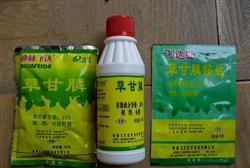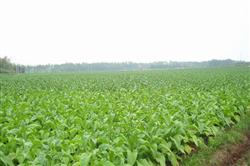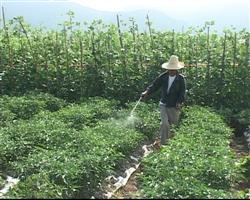How does glyphosate work? Residue period of glyphosate herbicide pesticides in soil

How to use glyphosate? Please give me an introduction
Glyphosate has a killing effect only when it comes into contact with green tissue. Due to the different sensitivity of various weeds to glyphosate, the dosage is also different.
1. Orchards, mulberry orchards and other weeds control annual weeds with 10% water agent 0.5-1 kg per mu, and perennial weeds with 10% water agent 1-1.5 kg per mu. 20-30 kg of water, directional spray on weed stems and leaves.
two。 Weeding in farmland before stubble sowing, weeds that have grown in the field can be controlled, and the dosage can be used according to orchard weeding. When cotton is used in growing period, it is necessary to use directional spray with cover. Use 10% water agent 0.5-0.75 kg per mu and 20-30 kg for water.
3. Fallow land, field edge, roadside weeding in the weed 4-6 leaf stage, use 10% water agent 0.5-1 kg per mu, add 100 ml of diesel oil, 20-30 kg of water, spray on weeds.
4. For some malignant weeds, such as Cyperus roxburghii Reed, auxiliaries can be added according to 200g per mu, and the weed control effect is good.
Glyphosate (glyphosate) is a herbicide developed by Monsanto in the United States. Also known as: Zhencaoning, Nongda (Roundup), glyphosate, phosphonic acid. The pure product is a non-volatile white solid with a specific gravity of 0.5. it melts at about 230℃ and is accompanied by decomposition. The solubility in water at 25 ℃ is 1.2%, insoluble in general organic solvents, and its isopropylamine salt is completely soluble in water. Non-flammable, non-explosive, stable storage at room temperature. It can corrode medium carbon steel and galvanized iron sheet (tinplate).
Usage
glyphosate has killing effect only when it comes into contact with green tissue. Due to the different sensitivity of various weeds to glyphosate, the dosage is also different.
1. Orchards, mulberry orchards and other weeds control annual weeds with 10% water agent 0.5-1 kg per mu, and perennial weeds with 10% water agent 1-1.5 kg per mu. 20-30 kg of water, directional spray on weed stems and leaves.
two。 Weeding in farmland before stubble sowing, weeds that have grown in the field can be controlled, and the dosage can be used according to orchard weeding. When cotton is used in growing period, it is necessary to use directional spray with cover. Use 10% water agent 0.5-0.75 kg per mu and 20-30 kg for water.
3. Fallow land, field edge, roadside weeding in the weed 4-6 leaf stage, use 10% water agent 0.5-1 kg per mu, add 100 ml of diesel oil, 20-30 kg of water, spray on weeds.
4. For some malignant weeds, such as Rhizoma Cyperi, Reed, etc., auxiliaries can be added according to 200 grams per mu, and the weeding effect is good.
The temperature of use is:
Suitable temperature conditions: high temperature, high speed of weed absorption, large quantity, difficulty in metabolic decomposition, easy to achieve the purpose of weeding. The control effect of herbicides can reach more than 80% when the daily average temperature is more than 10 ℃. In the range of 15 ℃-25 ℃, the effect is the best, but it is not more than 30 ℃. Too high temperature is easy to cause poisoning, and some herbicides can cause drug damage when applied at high temperature. The effect is only half when the temperature is lower than 10 ℃, and it is basically ineffective when the temperature is lower than 5 ℃. Therefore, the use of herbicides in low temperature season must be carried out when the temperature is high. The effect of using herbicide at low temperature is longer than that at high temperature. for example, using cover grass can control the weed Kentucky bluegrass in rape field, it usually takes 12-15 days to wither, while in summer kenaf field to control dogtail grass, generally only 3-5 open will kill the weeds in the whole field.
The half-life of glyphosate digestion is 10-16 days, and in theory, pesticides do not degrade 100% in crops or soil.
Residue of some herbicides
2. Quizalofop: the digestion half-life is within one day, and in sesame soil and sesame plants, the digestion half-life is about 1.5 days.
4. Acetochlor: Acetochlor was mainly used in the soil after sowing and before emergence, and its effective period in the soil was 8-10 weeks.
6. Metolachlor: the duration of effect in soil is 60-80 days.
8. Paspalum: the average digestion half-life in rice plants and soil was 1.2 days and 1.3 days respectively.
10. Clomazone: the digestion half-life in soil is 10-137 days, the duration is at least 6 months, and the crop rotation interval is also different, including 9-12 months for corn, 12-16 months for wheat, peanut, millet, sunflower and vegetables, and 9 months for sugar beet and sorghum.
12. Glyphosate: the digestion half-life in soil is 10-16 days.
14. Pendimethalin: the half-life in soil is 14.7-19.5 days, and the residual period is generally 6-9 weeks.
16. Isoxazolone: it can provide a duration of 8-10 weeks, planting soybeans, sorghum, sunflowers, potatoes and tomatoes at least 6 months, wheat in 4 months and rice, peanuts, millet, cotton and vegetables in 18 months.
19. Isoproturon: the half-life of soil is about 20 days, and the effective period of autumn application is 2-3 months.
21. Nicosulfuron: the digestion half-life is 9.63-13.59 days, with an interval of at least 8 months for wheat, 10 months for soybeans, cotton and peas, 12 months for rice and peanuts, and 18 months for vegetables and other crops.
- Prev

How to use diachlor in tobacco fields?
How to use diachlor in tobacco fields? Please give guidance to tobacco with small seeds and slow seedling growth, which are often harmed by weeds, such as Setaria mandshurica, Artemisia angustifolia, barnyard barnyard, sophora, sedge, pig calamity, plume, plantain, dandelion and so on. The control of weeds in tobacco field can.
- Next

How do vegetables use plant growth regulators?
How do vegetables use plant growth regulators? Please give guidance on the application of plant growth regulators to vegetables can refer to the following methods: 1. According to the purpose of use, to determine the appropriate concentration of plant growth regulators should use different concentrations according to the purpose of use, different types of vegetables and different periods. ...
Related
- Fuxing push coffee new agricultural production and marketing class: lack of small-scale processing plants
- Jujube rice field leisure farm deep ploughing Yilan for five years to create a space for organic food and play
- Nongyu Farm-A trial of organic papaya for brave women with advanced technology
- Four points for attention in the prevention and control of diseases and insect pests of edible fungi
- How to add nutrient solution to Edible Fungi
- Is there any good way to control edible fungus mites?
- Open Inoculation Technology of Edible Fungi
- Is there any clever way to use fertilizer for edible fungus in winter?
- What agents are used to kill the pathogens of edible fungi in the mushroom shed?
- Rapid drying of Edible Fungi

